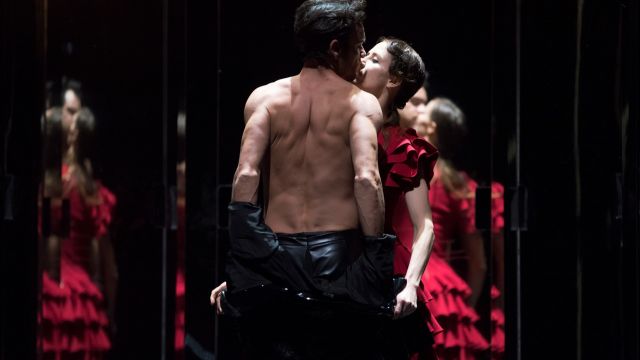Carmen
Ballett Dresden’s version of Carmen is a different beast from the usual versions of this story. This is a fiercely beautiful, at times voyeuristic examination of physical attraction, terrifying jealousy and violence.
Inger’s version of Carmen seemed to me to have more in common with the tragedies of Ancient Greece than the flamenco gypsies of the Bizet story we are so familiar with. This is a darker, more frantic, more visceral version, and the stage is populated with a raw energy that feels as if it is only just being controlled. An example of this is the scene in the tobacco factory, where the intensity heats ups to the extent of girls appearing like ‘dogs in heat’, snarling, and fighting with each other. An addition to the story is the group of ‘smelling dogs’; these grey camouflaged dancers appear from the shadows as if they ‘smell’ the possibility of a feed, a fight or blood. The smelling dogs are the movers of the dead, the harbingers of danger and the ever-lurking shadows of dread in many relationships.
The dancers are superb. The ensemble and chorus work is hypnotic and totally engaging.
 The main dancers, Carmen performed when I attended by Ayaha Tsunaki, Jón Vallejo as Don José, Gareth Haw as Officer Zúñiga and Christian Bauch as the Toreador, all received a well-deserved standing ovation when I attended. The final character, an addition to the traditional cast list, is that of the boy, played by Anna Merkulova. The boy becomes the witness, the innocent bystander, the chorus, and a person who is traumatised by the events and so is an interesting and successful addition to the interpretation offered by Inger.
The main dancers, Carmen performed when I attended by Ayaha Tsunaki, Jón Vallejo as Don José, Gareth Haw as Officer Zúñiga and Christian Bauch as the Toreador, all received a well-deserved standing ovation when I attended. The final character, an addition to the traditional cast list, is that of the boy, played by Anna Merkulova. The boy becomes the witness, the innocent bystander, the chorus, and a person who is traumatised by the events and so is an interesting and successful addition to the interpretation offered by Inger.
We cannot leave out the music. The thing that most of us most readily connect with the story is a mixture of a recognisable score, Rodion Shchedrin’s Carmen Suite, based on the original score by Bizet, and new music composed for the ballet by Marc Álvarez. It is a fine juggling act to create a sustained piece of music that is underlaid by familiar tunes and then deliberately jolts the audience out of their comfort zone into the more nebulous one that describes: “…the spirit of the characters that reflect the drama of the story.” Marc Álvarez. However, it is ultimately successful and helps to create a thematically consistent and exciting reinterpretation of an old story.
Carmen is dressed in red; red for passion, red for blood, red for violence, red to draw your eye directly to the wearer. The costumes designed by the late David Delfín, are for the most part timeless versions of the modern suit and sober day clothes, linking the story to modern concerns about violence against women.
The staging, designed by Curt Allen Willmer, constantly changes and shifts as he uses a modern version of the periaktos, or triangular prisms, to change the locations. The nine prisms, with their three sides of plain concrete, a corrugated material and mirrors, are used to define the space, creating streetscapes, factory workplaces, an arena and even a musical box-style wardrobe for the egotistical Toreador.
The lighting, by Tom Visse, reinforces the locations and moods, starting brighter and becoming increasingly shadowy and dark until finally the periaktoi become a mirrored tunnel of light, into which Carmen walks, leaving her red dress in the greyness of the world.
Carmenby Ballett Dresden is a compellingly beautiful and frightening re-interpretation of this classic story.
Sally Putnam
Photographer: Jesús Vallinas for Compania Nacional de Danza
Subscribe to our E-Newsletter, buy our latest print edition or find a Performing Arts book at Book Nook.

